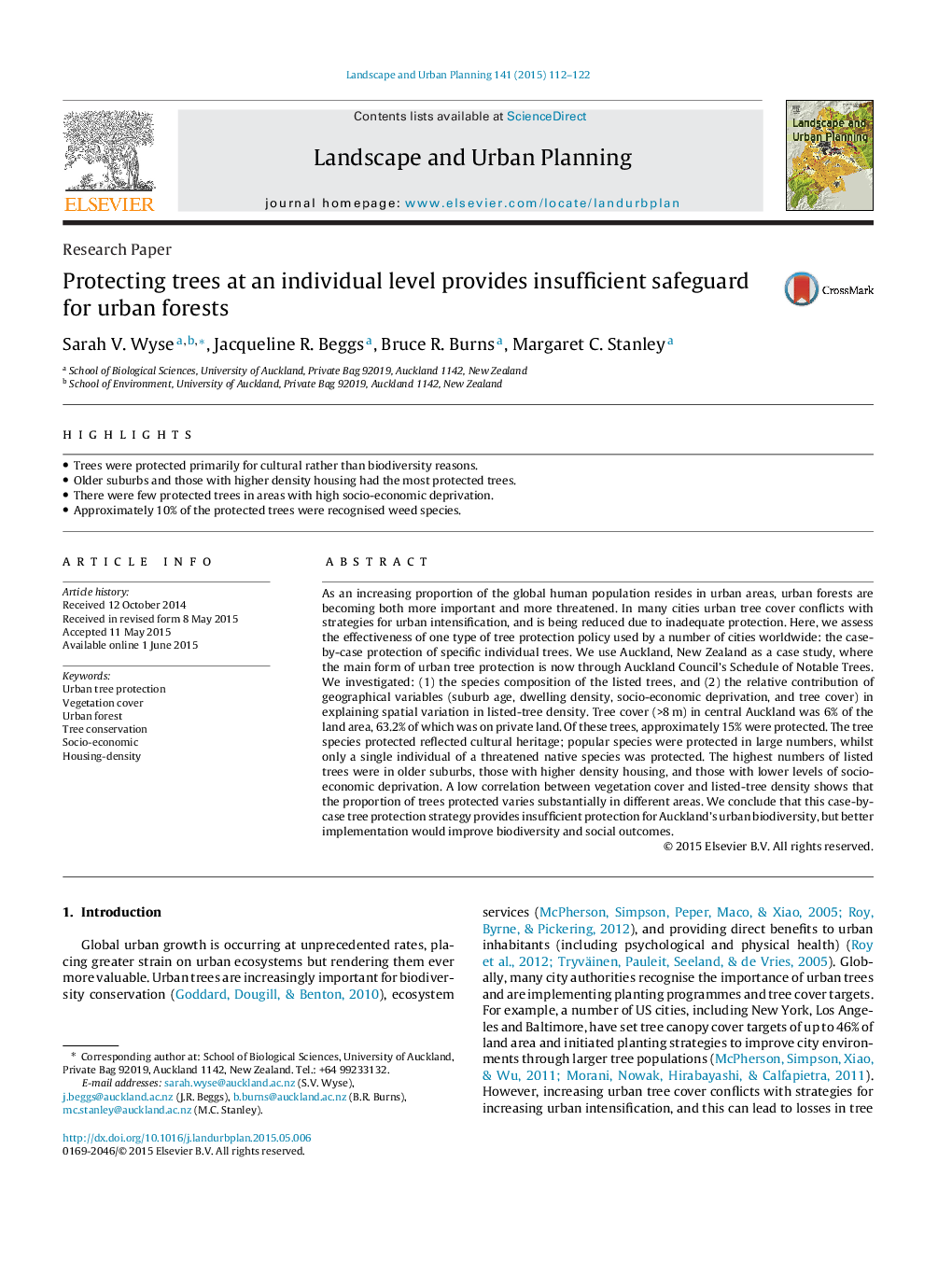| کد مقاله | کد نشریه | سال انتشار | مقاله انگلیسی | نسخه تمام متن |
|---|---|---|---|---|
| 7461126 | 1645231 | 2015 | 11 صفحه PDF | دانلود رایگان |
عنوان انگلیسی مقاله ISI
Protecting trees at an individual level provides insufficient safeguard for urban forests
ترجمه فارسی عنوان
حفاظت از درختان در سطح فردی حفاظت کافی برای جنگل های شهری را فراهم می کند
دانلود مقاله + سفارش ترجمه
دانلود مقاله ISI انگلیسی
رایگان برای ایرانیان
کلمات کلیدی
حفاظت از درختان شهری، پوشش گیاهی، جنگل شهری، حفاظت درخت، اجتماعی و اقتصادی، تراکم مسکن،
ترجمه چکیده
به عنوان بخش افزایشی از جمعیت جهانی انسانی در مناطق شهری، جنگل های شهری در حال تبدیل شدن به هر دو مهمتر و تهدید تر می شوند. در بسیاری از شهرها دره های شهری درگیری با استراتژی های تشدید شهری درگیر است و به دلیل حفاظت نامناسب کاهش می یابد. در اینجا، ما اثربخشی یک نوع سیاست حفاظت درختی را که توسط تعدادی از شهرها در سراسر جهان مورد استفاده قرار می گیرد، ارزیابی می کنیم: حفاظت از مورد در مورد درختان خاص. از آکویلند، نیوزیلند به عنوان نمونه مورد استفاده استفاده می کنیم، که در آن، شکل اصلی حفاظت از درختان در حال حاضر از طریق برنامه شوراهای آکسلند درختان قابل توجه است. ما بررسی کردیم: (1) ترکیب گونه ای درختان ذکر شده و (2) سهم نسبی متغیرهای جغرافیایی (سن حومه، تراکم مسکن، محرومیت اجتماعی-اقتصادی و پوشش درخت) در توضیح تنوع فضایی در تراکم چوب ذکر شده. پوشش درخت (> 8 سانتیمتر) در مرکز اوکلند 6 درصد از سطح زمین بود که 63.2 درصد آن در زمین های خصوصی بود. از این درختان، تقریبا 15٪ محافظت شد. گونه های درختی منعکس کننده میراث فرهنگی بود گونه های معروف در تعداد زیادی محافظت شدند، در حالی که تنها یک فرد از گونه های بومی تهدید شده محافظت می شد. بیشترین تعداد درختان ذکر شده در حومه های بزرگتر، افراد با مسکن با تراکم بالا و افرادی با مقادیر پایین تر از محرومیت اجتماعی و اقتصادی بود. همبستگی کم بین پوشش پوشش گیاهی و تراکم چوب نشان داده شده است که نسبت درختان حفاظت شده در مناطق مختلف متفاوت است. ما نتیجه می گیریم که این استراتژی حفاظت از درخت مورد در هر صورت حفاظت کافی برای تنوع زیستی شهری شهر اوکلند را فراهم می کند، اما اجرای بهتر، تنوع زیستی و نتایج اجتماعی را بهبود می بخشد.
موضوعات مرتبط
علوم زیستی و بیوفناوری
علوم کشاورزی و بیولوژیک
بوم شناسی، تکامل، رفتار و سامانه شناسی
چکیده انگلیسی
As an increasing proportion of the global human population resides in urban areas, urban forests are becoming both more important and more threatened. In many cities urban tree cover conflicts with strategies for urban intensification, and is being reduced due to inadequate protection. Here, we assess the effectiveness of one type of tree protection policy used by a number of cities worldwide: the case-by-case protection of specific individual trees. We use Auckland, New Zealand as a case study, where the main form of urban tree protection is now through Auckland Council's Schedule of Notable Trees. We investigated: (1) the species composition of the listed trees, and (2) the relative contribution of geographical variables (suburb age, dwelling density, socio-economic deprivation, and tree cover) in explaining spatial variation in listed-tree density. Tree cover (>8Â m) in central Auckland was 6% of the land area, 63.2% of which was on private land. Of these trees, approximately 15% were protected. The tree species protected reflected cultural heritage; popular species were protected in large numbers, whilst only a single individual of a threatened native species was protected. The highest numbers of listed trees were in older suburbs, those with higher density housing, and those with lower levels of socio-economic deprivation. A low correlation between vegetation cover and listed-tree density shows that the proportion of trees protected varies substantially in different areas. We conclude that this case-by-case tree protection strategy provides insufficient protection for Auckland's urban biodiversity, but better implementation would improve biodiversity and social outcomes.
ناشر
Database: Elsevier - ScienceDirect (ساینس دایرکت)
Journal: Landscape and Urban Planning - Volume 141, September 2015, Pages 112-122
Journal: Landscape and Urban Planning - Volume 141, September 2015, Pages 112-122
نویسندگان
Sarah V. Wyse, Jacqueline R. Beggs, Bruce R. Burns, Margaret C. Stanley,
